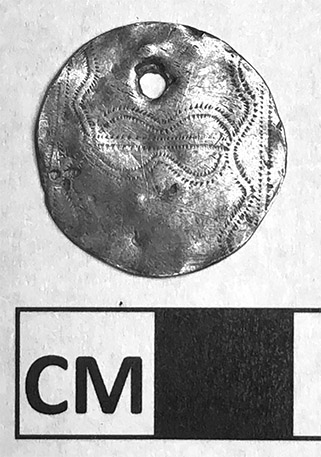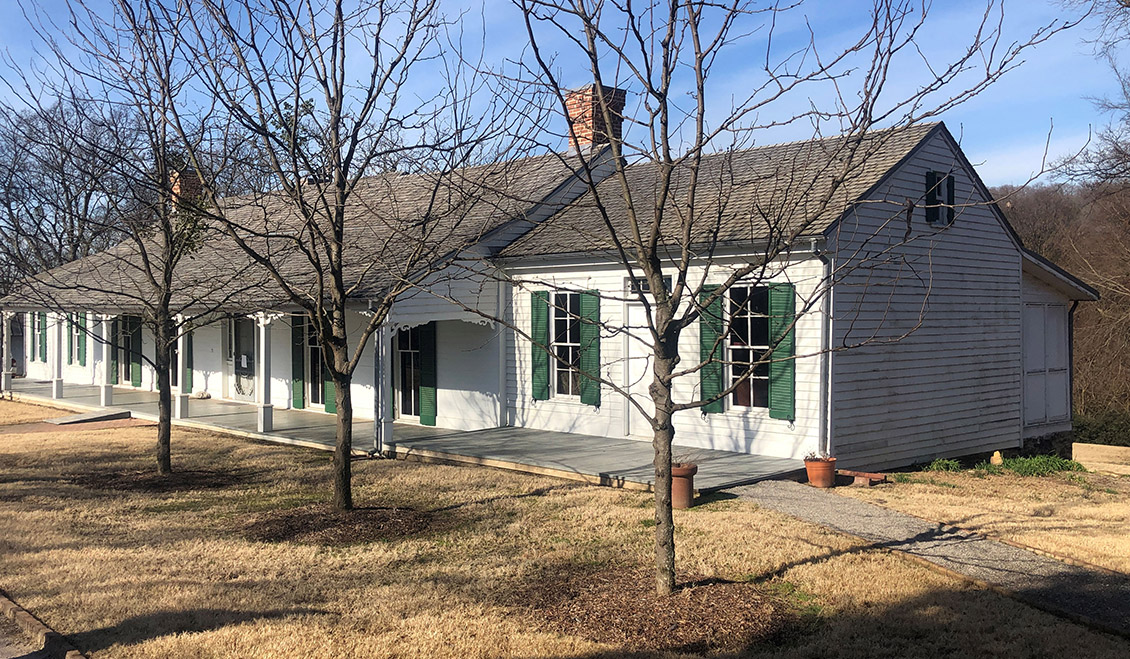
Tim Mulvihill, ARAS-UAFS Research Station
Artifact of the Month - February 2020
This pendant was handmade from silver, possibly from a hammered-out silver coin, with a design engraved into one side, and a perforation near the top used to either suspend it around the neck or otherwise fasten it to clothing. The engraved design is composed of tiny linear punctations forming lines, both straight and curved. It has a flat, disk-like shape measuring 1.78cm x 1.72cm, and its thickness varies from 0.52mm to 0.60mm.

The artifact was discovered in 2007 during excavations by the Arkansas Archeological Survey (ARAS) below the front porch of the Drennen-Scott house, which is located in Van Buren, Arkansas, and is owned by the University of Arkansas - Fort Smith (UAFS). John Drennen, one of the founders of Van Buren, began building the house in 1838. The ARAS-UAFS Research Station has been conducting research at the site since 2006 as part of a cooperative agreement with UAFS. The rehabilitation of the house into a museum and teaching laboratory for the Historic Interpretation program involved a great deal of construction and ground disturbance. Excavations usually preceded any ground disturbance to preserve and/or record the archeological information. During the rehabilitation work, the porch was returned to a wood structure, removing the brick porch that the family had installed in the early 1900s, and excavations under the porch took place at that time. The silver pendant was found during these excavations, at the transition between the original ground surface and fill that had been added for the brick porch. Additional artifacts found in the same deposit included 19th century ceramics, nails, and various types of glass.

Prehistorically, copper from the Great Lakes area was the only metal worked extensively by Indians in the eastern part of North America. It was shaped by cold hammering or annealing into tools, items of adornment, and during Mississippian times, into repoussé plates. After silver became available in the way of coins, bridles, spoons, and other European goods, many Indians became skilled silversmiths. David Bushnell, in his report on the Choctaw living near Bayou Lacomb in Louisiana in 1909, recounts: “Among the older men are remembered several who were experts in the art of making silver ornaments. One small pin… was made from a silver dime and the date 1856 still may be clearly read on the back” (Bushnell 1909:11). Excavations by the archeologists of the Ouachita National Forest at the Herndon site in Oklahoma (a Choctaw site occupied shortly after removal) found several silver artifacts including cones, and an oblong silver artifact with an engraved design similar to the one featured here (Etchieson 2012).
Discovery of the silver pendant at the Drennen-Scott Historic Site illuminates details of Drennen’s career and the history of Native Americans in Arkansas. Drennen was appointed agent to the Choctaw Nation and acting superintendent for Indian affairs for the southern district, which meant overseeing all five “Civilized Tribes” removed to Oklahoma (Wing 2015:26). “He maintained an office at his home in Van Buren, and tribal members were frequently there” (Kent 2017). Although we cannot say for sure that this silver pendant was made by the Choctaw specifically, it is likely of 19th century Indian origin and supports the idea that there was interaction between Drennen and members of the removed tribes on his property.

